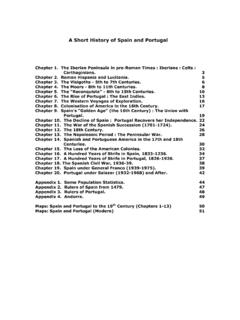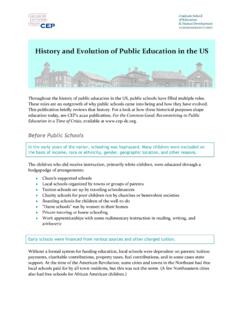Transcription of Reading Fluency: A Brief History, the Importance of ...
1 1. Reading Fluency: A Brief History, the Importance of Supporting Processes, and the Role of Assessment Dr. David D. Paige Northern Illinois University July 30, 2020. While Reading fluency has been extensively studied as an independent Reading process, it is better thought of as an outcome of multiple, lower-level Reading skills that when functioning in a synchronous and efficient manner, results in smooth, expressive Reading that's critical to understanding text. This review begins by defining Reading fluency, and then provides a Brief history of how the conceptualization of Reading fluency has changed over the past two centuries . It then discusses the important Reading processes that are responsible for fluent Reading before reviewing several studies that emphasize the Importance of Reading fluency to making meaning of text.
2 The review concludes with a rationale for why Reading fluency, and the foundational processes that lead to fluent Reading , must be regularly assessed in students. Defining Fluency Reading fluency has been through multiple conceptualizations. These include the rapid Reading of individual words, Reading words correctly, the speed at which one can read connected text, and Reading with expression. Fluent Reading is now conceptualized by Reading scholars as a construct composed of three facets, or indicators. These include 1) the rate of one's Reading , 2). the accuracy at which words are pronounced, and 3) the prosody (meaning expression) in one's voice that brings a text to life1. While the indicators are individually identified, they work interactively to produce fluent Reading . For example, the rate or pace with which one reads often simulates, to a loose extent, the pace of spoken language.
3 Correctly pronouncing individual words is important to Reading fluency is defined by maintaining a smooth rate, otherwise the reader must stop to Reading rate, word identification analyze and determine how to say the word which breaks the accuracy, and prosody smoothness of the Reading . As in speech, prosody is important (expression). to understanding the various interpretational nuances of the text, as it is in a conversation. Imagine speaking with someone who talks in a flat, monotone voice. Much interpretation would be lost and frankly, interest in the conversation would quickly wane. So while fluency can be defined as three distinct indicators, they work interactively with each other to produce smooth Reading that is both pleasant to listen to and as with speech, aids understanding. Fluency has most often been interpreted by researchers as a measurement metric called words-correct-per-minute (WCPM) or correct-words-per-minute (CWPM) which is calculated as the total number of words read ( Reading rate) minus Reading miscues (mispronounced words, words not read, words inserted, and skipped words) over the course of one minute.
4 The problem with this definition is the exclusion of prosody, the third indicator of Reading . To facilitate clear understanding among the Reading community, particularly teachers, the term accumaticity has 2. been recently introduced to refer to the measurement metric of words-correct-per-minute2 while fluency refers to all three indicators. Because Reading fluency has experienced a variety of interpretations as to its role and Importance in Reading that continues to evolve today, a Brief overview of how fluency has been viewed will provide perspective. A Brief History Reading instruction in early America emphasized the oral Reading of text4. Several book series, such as the McGuffey's Eclectic Reading Series (1853)3, were popular as resources for learning to read. The following quotation from the fifth edition positions the role of articulation within fluent Reading : The first step to be taken by one who desires to become a good reader or speaker, is to acquire a habit of distinct articulation.
5 Without this, the finest voice, the utmost propriety of inflection, and all the graces of articulation, fail to please. (p. 13). Articulation, as used in McGuffey's, refers to the clear accentuation of words by the reader. Oftentimes, oral Reading occurred in public spaces (churches, lecture halls, etc.) without the aid of amplifying devices, necessitating understandable, fluent Reading . The McGuffey's reader goes on to mention what would be considered the qualities of Reading fluency today a Reading rate that loosely simulated oral conversation, accurate word pronunciation, and the appropriate use of prosody, all meant to keep listeners engaged in the Reading . By the early twentieth century an increasing number of children were enrolled in formal education. As Reading was now more likely to occur silently, the emphasis on oral Reading declined, although it was still used as a way to assess a student's Reading progress4.
6 About this time the psychologist Edmund B. Huey (1908)5 published The Psychology and Pedagogy of Reading , the first book to review the science of Reading . In the late nineteenth century psychologists had invented the first machines to track one's eyes while Reading that provided a gateway into the cognitive processing of text. Research in this field led to new insights about Reading , some of which resulted in faulty conclusions ( , that all readers read words as a single whole ) while others remain basically correct today. These early psychologists discovered that even good readers do not smoothly move their eyes across the text, but rather, eyes move both left and right as the reader advances across a sentence. The middle of the twentieth century brought additional changes to Reading instruction.
7 A. prominent textbook on the teaching of Reading had been authored by Emmett Betts (1950)6, a professor of Reading at Temple University and formerly Pennsylvania State College. Reading was now conceptualized as a facet of language, an idea that is fundamental to today's view of literacy7. While Betts acknowledged that most Reading occurred silently, oral Reading was perceived as having an important place in the Reading program. Critical thinking was encouraged 3. in students as a way to evaluate the author's message in light of the student's background knowledge. Based on insights from a dissertation conducted by Killgallon (1942)8, Betts recommended what is still considered today, the golden rule for instructional text. Although Killgallon did not construct text complexity guidelines, Betts deemed any text where the student could not correctly pronounce at least 90% of the words as too difficult to read and to be avoided (frustration level).
8 Texts were considered instructionally appropriate (to be read in conjunction with a teacher) if the words were read with 95% accuracy, while texts where word identification accuracy equaled 99% or better were judged appropriate for independent Reading . Shanahan9. researched Killgallon's dissertation and found no empirical evidence to support these recommendations. None the less, these percentages are perhaps the most enduring rules (74 years running to date) in Reading education despite research debunking them10,11, 12. The instructional problem with Betts' rule is that many teachers are leery of allowing students to read text that is above their instructional level. Such decisions ignore the power of student interest and motivation and artificially constrain the scaffolding of text complexity that limits the reader's experience with the texts needed to develop college- and career-ready Reading skills.
9 Also, at risk is the reader's growth of core or global knowledge that is important to comprehension. Validation of Fluency Interventions In the late 1970's and early 80's, fluent Reading as an instructional goal had become largely ignored. In a seminal article in 1983, Allington13 noted that while students often lacked fluent Reading , it was rarely addressed with fluency instruction, rather, teachers tended to focus on improvement of word automaticity. While word automaticity is important to fluent Reading , students must still learn to read words in connected text and become familiar with syntax that tends to become increasingly sophisticated as text complexity increases across grades. Reading fluency has been largely neglected. To unbundle the interaction between word automaticity Richard Allington, 1983.
10 And fluency, Dahl and Samuels14 conducted a study in 1973 to improve Reading fluency where one group of students practiced automaticity at the word level while the other engaged in Reading fluency practice with connected text. Students in the fluency development group showed significant improvement beyond those who worked solely on word automaticity. Two seminal studies, one by Chomsky15. in 1978 and a second by Samuels16 in 1983, examined the efficacy of repeated readings to improve Reading fluency. In a repeated Reading strategy, students read a short text of 100 to 200. words four times or so over several days. Readings are conducted in the company of a teacher or more knowledgeable reader to assist with difficult word pronunciations. The two studies established that practice using repeated readings decreased word mispronunciations and improved Reading rate, resulting in improved Reading fluency.
















